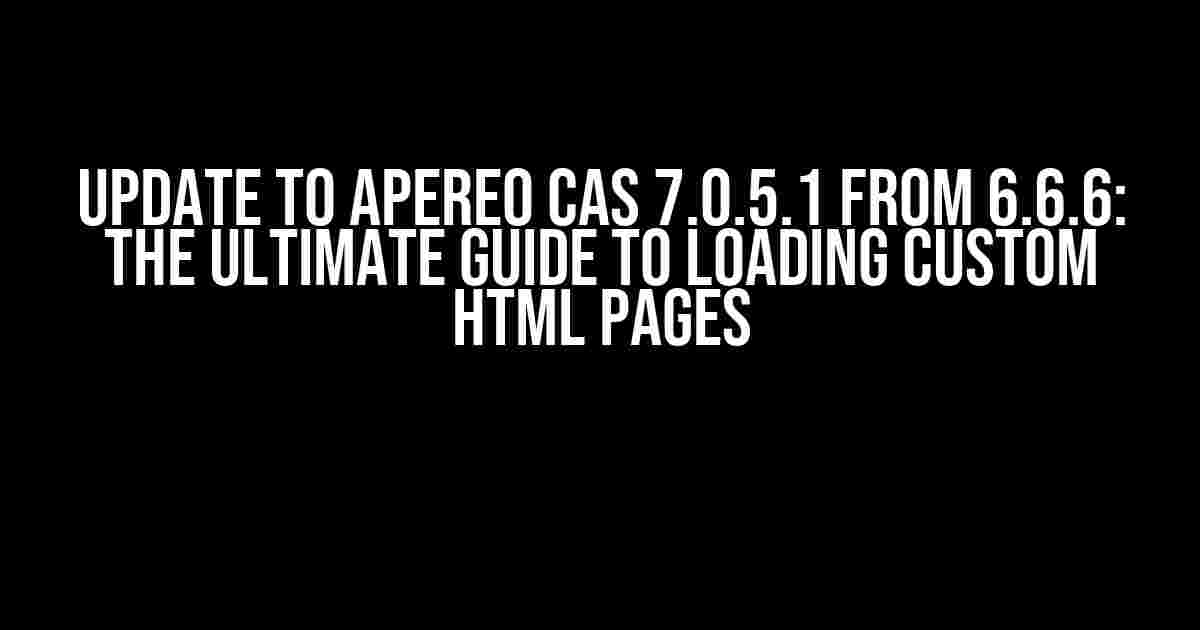Welcome to this comprehensive guide, where we’ll delve into the world of Apereo CAS and explore the challenges of loading custom HTML pages from the src/main/resources/templates directory after upgrading to version 7.0.5.1 from 6.6.6. If you’re struggling to get your custom pages up and running, fear not! By the end of this article, you’ll be well-equipped to tackle this issue and enjoy the benefits of the latest CAS version.
Understanding the Problem
When upgrading from Apereo CAS 6.6.6 to 7.0.5.1, you might have noticed that your custom HTML pages, carefully crafted and placed in the src/main/resources/templates directory, are no longer being loaded. This can be frustrating, especially if these pages are crucial to your application’s functionality. So, what’s going on?
The root cause of this issue lies in the changes made to the CAS configuration and template engine in version 7.0.5.1. In this version, the Thymeleaf template engine is used by default, replacing the previously used Freemarker engine. While this change brings many benefits, it also requires adjustments to your configuration and template structure.
Preparing for the Update
Before diving into the solution, let’s take a step back and review the requirements for updating to Apereo CAS 7.0.5.1 from 6.6.6:
- Ensure you have a compatible Java version (Java 11 or higher) installed on your system.
- Update your dependencies to reflect the new CAS version.
- Review the CAS 7.0.5.1 release notes and changelog to understand the key changes and updates.
Configuring Thymeleaf Template Engine
To load custom HTML pages from the src/main/resources/templates directory, you’ll need to configure the Thymeleaf template engine. Follow these steps:
- In your
application.propertiesfile, add the following configuration: - In your
application.ymlfile (if you’re using YAML configuration), add the following configuration:
cas.thymeleaf.enabled=true cas.thymeleaf.templates.root=classpath:/templates/
cas:
thymeleaf:
enabled: true
templates:
root: classpath:/templates/
By enabling Thymeleaf and specifying the template root directory, you’re telling CAS to look for templates in the src/main/resources/templates directory.
Template Structure and Naming Convention
In CAS 7.0.5.1, the template structure and naming convention have changed. Make sure to adapt your templates to the new convention:
- Template files should be placed in the src/main/resources/templates directory.
- Template file names should follow the
template.[html|xml]naming convention (e.g.,login.htmlorResetPassword.xml). - Avoid using underscores (_) in template file names, as they are not supported.
Loading Custom HTML Pages
Now that you’ve configured Thymeleaf and adapted your template structure, it’s time to load your custom HTML pages:
Create a new file in the src/main/resources/templates directory, following the naming convention mentioned earlier (e.g., custom.html). Add your custom HTML content to this file.
<!DOCTYPE html>
<html xmlns:th="http://www.thymeleaf.org">
<head>
<title>Custom HTML Page</title>
</head>
<body>
<h1>Welcome to my custom HTML page!</h1>
</body>
</html>
In your CAS configuration file (e.g., cas.properties or cas.yml), add the following configuration to specify the custom page:
cas.view.json=/custom
Alternatively, you can configure the custom page in your CAS webflow configuration file (e.g., cas-webflow.xml):
<?xml version="1.0" encoding="UTF-8"?>
<flow-config>
<b:>
<bean id="customView" class="org.springframework.web.servlet.view.freemarker.FreeMarkerViewResolver">
<property name="templateEngine">
<bean class="org.thymeleaf.spring5.SpringTemplateEngine">
<property name="templateResolver">
<bean class="org.thymeleaf.spring5.templateresolver.SpringResourceTemplateResolver">
<property name="prefix"><value>classpath:/templates/</value></property>
<property name="suffix"><value>.html</value></property>
</bean>
</property>
</bean>
</property>
</bean>
</b:>
</flow-config>
Troubleshooting Tips
If you’re still experiencing issues with loading your custom HTML pages, try the following troubleshooting steps:
- Verify that your CAS configuration files are correctly updated and reflect the changes mentioned in this article.
- Check the CAS logs for any errors or warnings related to template loading or Thymeleaf configuration.
- Ensure that your custom HTML pages are correctly named and placed in the src/main/resources/templates directory.
- Try cleaning and rebuilding your CAS project to ensure that all changes are properly applied.
Conclusion
Upgrading to Apereo CAS 7.0.5.1 from 6.6.6 requires careful consideration of the changes to the Thymeleaf template engine and template structure. By following the steps outlined in this article, you should be able to successfully load your custom HTML pages from the src/main/resources/templates directory. Remember to adapt your templates to the new naming convention and structure, and don’t hesitate to reach out if you encounter any further issues.
| CAS Version | Template Engine | Template Structure |
|---|---|---|
| 6.6.6 | Freemarker | src/main/resources/templates |
| 7.0.5.1 | Thymeleaf | src/main/resources/templates (with Thymeleaf naming convention) |
By embracing the changes in CAS 7.0.5.1, you’ll be able to take advantage of the latest features and improvements, ensuring a more secure and efficient authentication experience for your users.
Frequently Asked Question
Having trouble with custom HTML pages not loading after updating to Apereo CAS 7.0.5.1 from 6.6.6? You’re not alone! Here are some frequently asked questions to get you back on track.
Why did my custom HTML pages stop working after updating to CAS 7.0.5.1?
When you upgraded to CAS 7.0.5.1, the template engine changed from Thymeleaf to FreeMarker. Make sure to update your custom HTML pages to use FreeMarker syntax and templates.
Where should I put my custom HTML pages in CAS 7.0.5.1?
In CAS 7.0.5.1, you need to put your custom HTML pages in the `src/main/resources/templates` directory, just like before. However, make sure to update the file names and contents to match the new FreeMarker syntax.
Do I need to configure anything else to get custom HTML pages working in CAS 7.0.5.1?
Yes, you need to configure the `cas.theme.banner.html` property in your `application.properties` or `application.yml` file to point to your custom HTML page. For example, `cas.theme.banner.html=file:/path/to/your/custom/banner.html`
How do I troubleshoot issues with custom HTML pages in CAS 7.0.5.1?
Check the CAS logs for errors related to template rendering or file loading. You can also try enabling debug logging for the `org.apereo.cas` package to get more detailed information. Additionally, make sure your custom HTML pages are correctly formatted and are being served by the CAS Tomcat server.
Are there any resources available to help me with custom HTML pages in CAS 7.0.5.1?
Yes, you can refer to the official Apereo CAS documentation, the CAS community forums, and the CAS GitHub repository for guidance on customizing HTML pages. You can also search for online tutorials and blogs that provide step-by-step instructions for creating custom HTML pages in CAS 7.0.5.1.
